|
On the 40th anniversary of its conclusion,
we remember the original River tour, tracing its route, focusing on significant events and on-the-road atmosphere on both sides of the Atlantic with contemporary news reports, reviews, and interviews

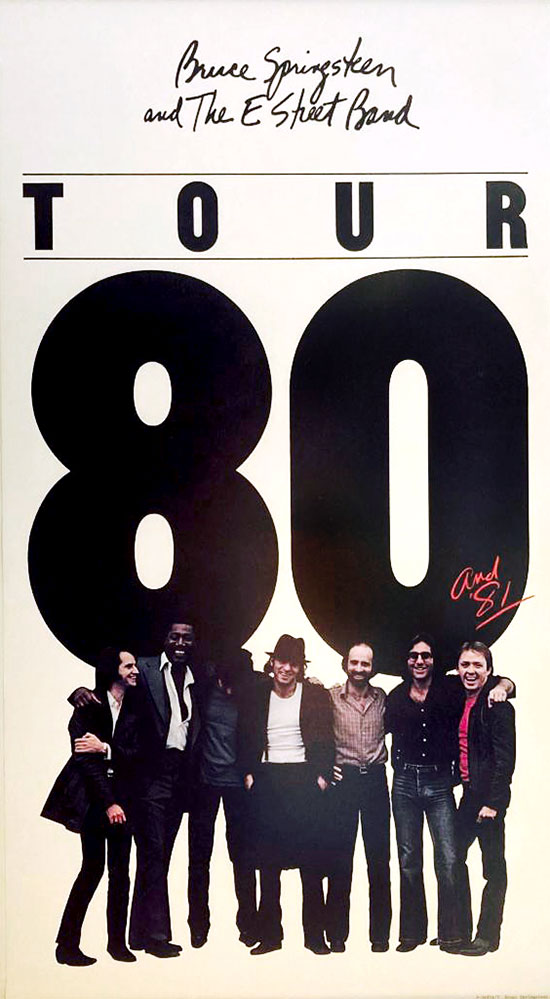 Four decades ago tonight, Bruce Springsteen and the E Street Band concluded their year-long tour in support of The River double album with the second of two nights at the Riverfront Coliseum in Cincinnati. Four decades ago tonight, Bruce Springsteen and the E Street Band concluded their year-long tour in support of The River double album with the second of two nights at the Riverfront Coliseum in Cincinnati.
In the fall of 1980, after a 21-month break from touring (his longest since he signed to Columbia), during which he shelved the planned The Ties That Bind single album and played the two No Nukes shows, Bruce emerged from the studio and commenced a new rock 'n' roll odyssey on which he widened his horizons, explored new territories, experienced a huge increase in popularity, and enjoyed his first Top Ten single and Number One album.
The River tour (105 gigs in North America, 17 in mainland Europe, and 16 in the U.K.) was a significant career milestone between the legendary Darkness tour in 1978 and the Born in the USA juggernaut in 1984 and 1985, and the first to bring any kind of financial reward.
"They must be bringing somebody from someplace"
Following two days of intensive rehearsals at Clair Brothers Audio in Lititz, PA in late September, Bruce kicked off the tour with a 26-song show at the University of Michigan's Crisler Arena in Ann Arbor on October 3, 1980. For the first time, he opened with his (then) most famous song, "Born to Run," forgetting the words in the process. ("Born to Run" began half the 1980 shows, alternating with "Prove It All Night" and, less frequently, "Badlands"). From the same album, "Thunder Road" was played twice: once in the first set (the mid-show interval introduced on the 1978 tour had been retained) and again as a final encore with local hero Bob Seger making a guest appearance.
Although The River would not be released for another two weeks, Bruce and the E Street Band performed 11 of its songs on this first night. It was an album that — like its cover photograph, shot in 1978 — was partly rooted in the Darkness sessions three years earlier. Several songs ("Independence Day," "Sherry Darling," "Point Blank," and "The Ties That Bind") were already familiar to fans who caught Springsteen live in 1978 or heard the tapes, and the title track was debuted at the No Nukes concerts in '79.
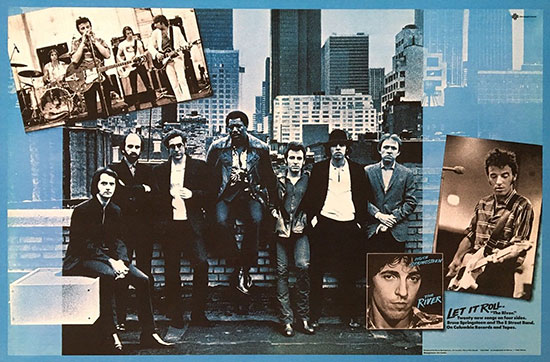
The Ann Arbor performance debuted the basic framework of the 1980 shows, which comprised a significant chunk (sometimes nearly all) of The River, approximately half of Born to Run and Darkness on the Edge Of Town, the then-unreleased "Fire" and "Because the Night," and the ever-present "Detroit Medley," which closed the majority of shows.
Material from Springsteen's first two records was less in evidence, but "Rosalita" remained a permanent fixture as the second-set closer, while "Growin' Up," "For You," and "4th of July, Asbury Park (Sandy)" made semi-regular appearances. Alternate album selections, occasional original rarities, once-only covers, and regular setlist tinkering kept the band on their toes and ensured that no two performances were the same.
"There are only a couple of small-hall dates on Bruce Springsteen and the E Street Band's 1980 tour," noted Fred Schruers in a lengthy Rolling Stone report that covered early shows in Chicago, St Paul, and Milwaukee. "In most cities, the only way to meet ticket demand is to play the kinds of arenas usually reserved for supergroups and pro sports teams. During two years off the road, the band's only exposure has been a segment in the No Nukes movie and album. The absence seems only to have built Springsteen's following."
"The last tour, the band played real hard every night and people just remembered," said Bruce. "This time everybody told their friends, 'you gotta come down to the show.' A lot of these places we didn't sell out before, so they must be bringing somebody from someplace."
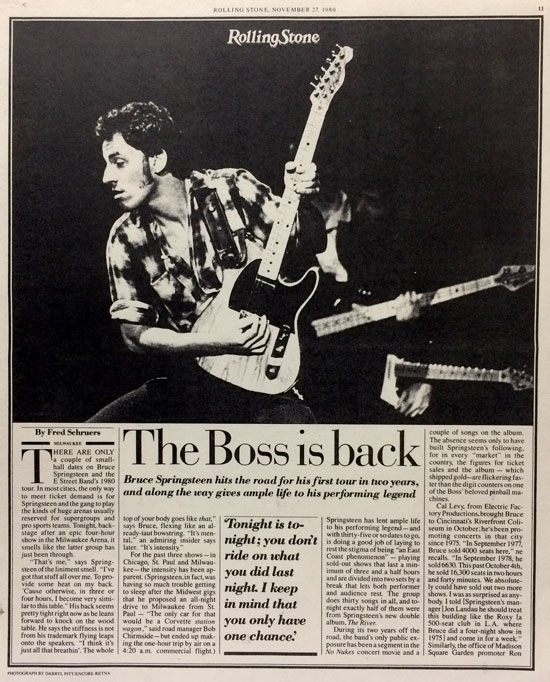
I'm bad, I'm nationwide
Schruers reviewed the October 14 Milwaukee show, where Bruce "opened with 'Prove It All Night,' did a ferocious rendition of 'Badlands' (clutching his guitar across his chest like a priceless talisman as he sang the line 'It ain't no sin to be glad you're alive') and ended up in the middle of a happy mob in the fifth row to holler 'I'm all alone' during 'Tenth Avenue Freeze-out.' The lights lowered for a brooding version of 'Stolen Car,' Garry Tallent's bass rumbling like distant, ominous thunder. His tight black shirt was soaking wet as he stormed through 'You Can Look (But You Better Not Touch).'" Bruce also called for "In the Midnight Hour," which the band hadn't played before. "We all just about fainted," remembered Miami Steve. "Garry didn't believe we were doing it until about the second chorus."
Throughout October, the tour meandered across to Denver, up to the Pacific northwest ("On Top of Old Smokey" was played in Portland to acknowledge the recent Mount St. Helens eruption), and then down the West Coast for two shows in Oakland en route to Los Angeles.

 In L.A. in July 1978, Bruce had played one show each at the Forum and the Roxy. This time around, he was booked for four performances at the Los Angeles Memorial Sports Arena (October 30, 31 and November 1, 3), proving he was now a nationwide phenomenon. Within months, he would also conquer the U.K. and Europe. In L.A. in July 1978, Bruce had played one show each at the Forum and the Roxy. This time around, he was booked for four performances at the Los Angeles Memorial Sports Arena (October 30, 31 and November 1, 3), proving he was now a nationwide phenomenon. Within months, he would also conquer the U.K. and Europe.
In an L.A. review headlined "Springsteen's Rock Crusade," the U.K.'s Melody Maker raved about "a phenomenal show" in which Bruce "uses up an incredible amount of physical energy, darts here and there, jumps onto speaker cabinets, leaps in the air, runs into the audience. The band [hugs] the shadows in a semi-circle, to allow maximum room for Bruce and Clarence to act out the drama."
"It's past midnight, but they're back for more encores," Sounds raved from L.A. "'Jungleland,' shot like a movie with fading lights, and the rock and roll medley with wild dancing, on his knees, in the crowd. Delirium, until there's nothing left of the guy to give. If this is rock and roll heaven, book me a flight."
On opening night at the Sports Arena, Springsteen played 18 songs from The River, 11 of which appeared consecutively in the second set. Flo and Eddie sang backing vocals on "Hungry Heart," and for the first time, part of Chuck Berry's "No Money Down" was used as an intro to "Cadillac Ranch". The Los Angeles stand also brought the tour debuts of "The Price You Pay" (in an acoustic arrangement with Danny Federici on accordion for the final verse, this version alternating with a full-band take for the immediate future) and "Fade Away," which was transformed into a nine-minute epic.
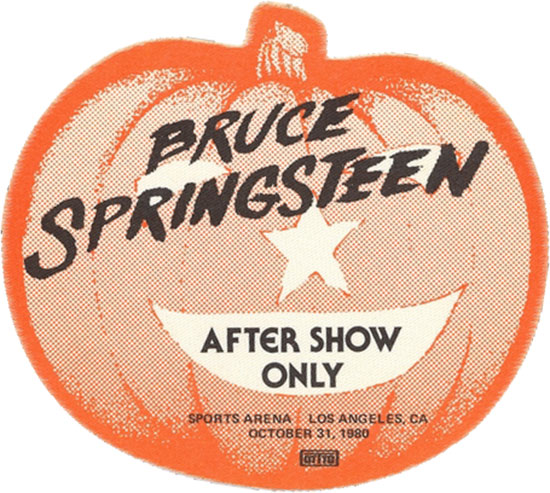
On Halloween night, Bruce opened with Johnny Fuller's 1958 single "Haunted House." He was carried onstage in a coffin and "chased around the stage by ghoul-robed roadies during the guitar break." Also played was the Marketts' 1964 surf-rock instrumental "Out of Limits," opening the second set. The third show featured a guest appearance by Jackson Browne for a once-only cover of "Sweet Little Sixteen"; Browne returned for the "Detroit Medley" on closing night. The last two shows also featured a brief return of the 1978 extended instrumental intro to "Prove It All Night."
While in Los Angeles, Bruce addressed the problem of ticket scalping (legal in California as long as it wasn't done at the event) onstage for the first time. "If you've gotta pay $200 to buy a ticket that's marked $12.50, it's not right, and you shouldn't stand for it," he told audiences each night. "Tickets should go to the fans, not the scalpers."
Springsteen also recorded a 30-second radio spot encouraging fans to support an antiscalping bill that had been introduced in the California State Assembly, and he lent his name to a newspaper ad with a similar message that had been taken out by his local promoter, Wolf and Rissmiller Concerts. Springsteen's booking agent Barry Bell said, "Scalpers ended up with blocks of eight to ten tickets in a row for every show, and you can't do that by mailing in requests."
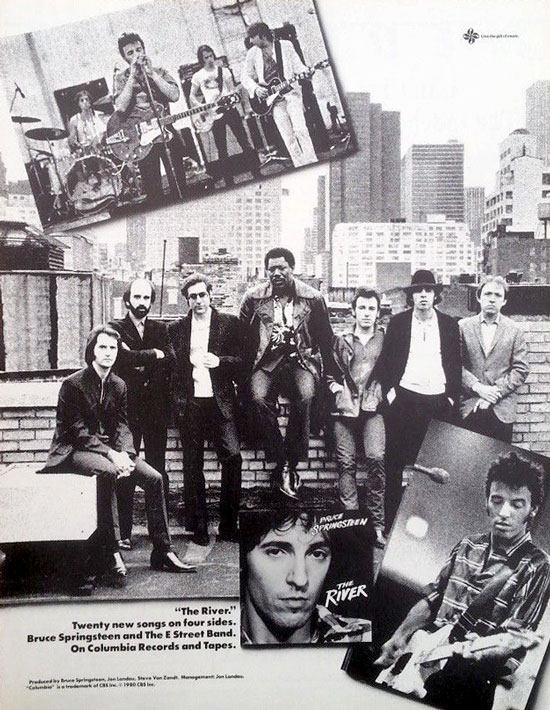
"We had a hit, a real one"
The day after the final show in Los Angeles, Republican nominee Ronald Reagan scored a landslide victory over incumbent Democrat Jimmy Carter in the U.S. presidential election. Springsteen, who announced Clarence Clemons as "the next president of the United States" onstage a few nights before, expressed his frustration with the result at the Arizona State University Activity Center in Tempe on November 5 ("I don't know what you guys think about what happened last night, but I think it's pretty frightening") before slamming into "Badlands."
It was a sobering moment, but there was also much cause for celebration, acknowledged by the amended lyrics of "Rosalita":
Tell your daddy this is his last chance
If he wants his daughter to have some fun
Because my brand new record, Rosie
Just came in at Number One!
 Not only had The River topped the charts, the "Hungry Heart" single (with its brief, high-energy, non-album B-side "Held Up Without a Gun") was also a big success. Not only had The River topped the charts, the "Hungry Heart" single (with its brief, high-energy, non-album B-side "Held Up Without a Gun") was also a big success.
"We had a hit, a real one," recalled Bruce in his 2016 autobiography. The single "went top ten, doubled our album sales, and brought to our live shows…women. Thank you, Jesus!" Previously his hardcore following had been primarily young and male, "but 'Hungry Heart' brought in girls and proved Top 40 radio's power to transform your audience."
The entire Tempe show was recorded, and 23 of the 33 songs were filmed by Barry Rebo and his team. The performance of "Badlands" (minus spoken intro) was released on Live/1975-85 in 1986, but Rebo's extremely rare tour footage didn't see the light of day until early December 2015, when it formed part of The Ties That Bind: The River Collection boxed set (which also included video of five songs from the Pennsylvania rehearsals in September). A few weeks later, audio of the remaining 10 songs from the Tempe concert were released via Springsteen's Live Archive series on Christmas Eve.
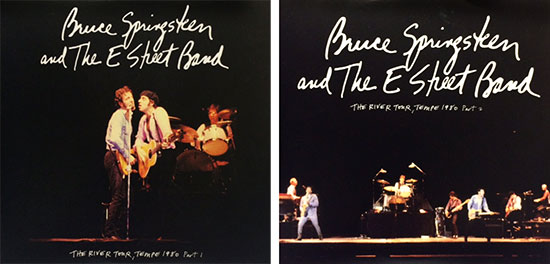
The show's running time (minus the interval that writers often included to promote the four-hour legend) was close to three hours and 40 minutes, which was typical at the time. Since Ann Arbor, Springsteen had increased the time he spent onstage each night from three to three-and-a-half hours a night and often longer.
For No Nukes a year prior, Springsteen had cut the length of his regular shows by half. "After those shows went over so great, I figured that's what we'd be doing on this tour," said Miami Steve. "Just 90 minutes, a couple of ballads, and make people as crazy as you can, like the old days. We can do that, but not Bruce. What we ended up doing was adding that 90 minutes to the show we always did."
"I think Bruce might actually play longer," commented Jon Landau, "except the band gets worn out."
"Doing it is the end, not the means"
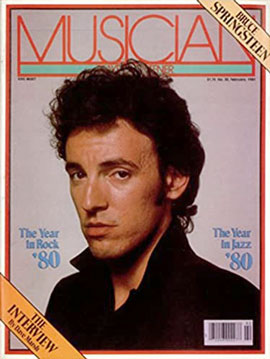 The following night, Bruce was interviewed by his biographer Dave Marsh (Born to Run: The Bruce Springsteen Story was published the previous year) at the Fiesta Motel in Tempe, between 3:30am and dawn. Their extensive conversation was eventually published in Musician magazine three months later. Now Bruce had a chart-topping album, a hit single, and was selling out arenas, Marsh suggested that he must have achieved many of his goals. The following night, Bruce was interviewed by his biographer Dave Marsh (Born to Run: The Bruce Springsteen Story was published the previous year) at the Fiesta Motel in Tempe, between 3:30am and dawn. Their extensive conversation was eventually published in Musician magazine three months later. Now Bruce had a chart-topping album, a hit single, and was selling out arenas, Marsh suggested that he must have achieved many of his goals.
"Doing it is the goal," replied Bruce. "Doing it is the end, not the means. That's the point. What's next? Some more of this. The idea was to reach people, and after tonight, you go out and you reach more people."
Springsteen explained the bond he has with his audience to Fred Schruers, who asked where Bruce found the energy to play such long shows, sometimes on three consecutive nights: "The audience brings a lot, even when you think you have nothing left. Tonight is tonight. You don't ride on what you did last night. I keep in my mind that you only have one chance. There's a promise made between musician and audience. When they support each other, that's a special thing. It goes real deep. It's at the heart of everything. I've got a lot of energy just naturally, but when I get onstage and I'm running on empty, I think of the promise to the guy or girl who's down there, a promise that's made from hundreds or thousands of miles away. It's no different than if you stood with this person and shook his hand."
The tour then flowed back east through Texas (two nights in Houston, one each in Dallas and Austin), Louisiana, and Maryland (two shows at the Capital Centre in Largo), to New York City in time for Thanksgiving.

 Bruce's four shows in Manhattan were split into two groups, three weeks apart: two on November 27 and 28, and two more on December 18 and 19. Bruce's four shows in Manhattan were split into two groups, three weeks apart: two on November 27 and 28, and two more on December 18 and 19.
"You couldn't tell from the way he raced across the stage, brandished his guitar like a sword, and dived head-first into the crowd, but during his marathon shows at Madison Square Garden, Bruce Springsteen was playing with a badly-sprained ankle," revealed Melody Maker. "He wore a tightly-wrapped bandage throughout the show and eased the pain in the backstage whirlpool used by the Knicks basketball and Rangers hockey teams. Springsteen also put in a brief appearance at a post-gig party in his honor at the Garden's upstairs bowling alley."
Ticket scalping was also a substantial problem In New York. Mark-ups of more than two dollars above face value were illegal there, but scalpers from New Jersey (where the practice was not prohibited) apparently obtained large quantities of tickets for the Garden shows.

Melody Maker reported: "Investigators from Springsteen's management, the Garden, promoter Ron Delsener, and the New York state attorney general's office are checking allegations that thousands of tickets were not sold by mail order, but fell into the hands of unscrupulous ticket agencies, who sold them with a $100 service charge." It was discovered that the Garden was "incredibly disorganized" at processing orders, and one postal employee was fired when found placing his own address labels over outgoing ticket orders.
Incognito in Buffalo
 After the first pair of Garden shows, Springsteen played two shows in Pittsburgh and single nights in Rochester and Buffalo, en route to a three-night stand in Philadelphia. For most of his December gigs, he brought back his seasonal cover of "Santa Claus Is Comin' to Town." Writer Fred Schruers also attended this series of shows, producing a major interview and on-the-road feature for Rolling Stone, published three months later. He apparently had extensive access to Springsteen, emphasising his easy accessibility despite his newfound success and increased public attention. After the first pair of Garden shows, Springsteen played two shows in Pittsburgh and single nights in Rochester and Buffalo, en route to a three-night stand in Philadelphia. For most of his December gigs, he brought back his seasonal cover of "Santa Claus Is Comin' to Town." Writer Fred Schruers also attended this series of shows, producing a major interview and on-the-road feature for Rolling Stone, published three months later. He apparently had extensive access to Springsteen, emphasising his easy accessibility despite his newfound success and increased public attention.
"Springsteen is happy in the front seat of anything, and he spends the ride from Rochester to Buffalo gazing at the sunny, snow-covered fields on either side of the highway. At the hotel, he tucks his cap under his sweatshirt's hood and invites me for a walk downtown in the 'fresh (22 degrees) air.' In boots and a well-broken-in black cloth coat, he looks like a gravedigger off for the winter. He has pored over the local record store's entire cassette case (choosing The Drifters and Gene Pitney) before the guys who work there recognize him. Still gimpy from a stumble he'd taken during a show in Washington, he walks on incognito until some salesgirls corner him for autographs in a bookstore.
 Schruers continues: "We cross the street to McDonald's. 'Paradise,' he calls it. 'I never did get comfortable with places that got the menu in the window,' he explains, making two Quarter-Pounders disappear. He looks contentedly around as the Buffalonians make no sign of recognizing him. 'I love coming to these places where it's nothing but real.'" Schruers continues: "We cross the street to McDonald's. 'Paradise,' he calls it. 'I never did get comfortable with places that got the menu in the window,' he explains, making two Quarter-Pounders disappear. He looks contentedly around as the Buffalonians make no sign of recognizing him. 'I love coming to these places where it's nothing but real.'"
The best example of Springsteen's desire to break down the barrier between performer and audience took place in St. Louis in October, when he saw Woody Allen's Stardust Memories (filmed in Asbury Park and other New Jersey locations), and was invited home afterwards with a fan and his sister.
"Went to the movies by myself, walked in, got popcorn," Bruce told Dave Marsh. "He had the amazing courage to come up to me at the end of the movie and ask me if I'd go home and meet his mother and father. So I go home with him, he lives out in some suburb. For two hours I was in this kid's house, talking to these people. They cooked me up all this food, and the guy gave me a ride home. That is something that can happen to me that can't happen to most people. You get somebody's whole life. You get their parents, their sister, their family life. And I went back to that hotel and felt really good. What an experience to be able to have, to step into some stranger's life."
Some would argue that Bruce took a huge risk with his personal safety that night. Several weeks later, the potential danger of such an encounter was brought chillingly into focus.
"There's just nothing else you can do"
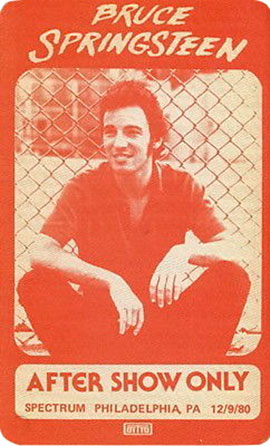 The last of Springsteen's three performances at the Philadelphia Spectrum on December 6, 8, and 9 was typically intense, but also fuelled by a raw emotional response to a tragic event. The last of Springsteen's three performances at the Philadelphia Spectrum on December 6, 8, and 9 was typically intense, but also fuelled by a raw emotional response to a tragic event.
News about the murder of John Lennon in Manhattan broke while the band were still onstage on December 8. In Danny Federici's words, "they saved it from us until after the show."
According to Fred Schruers, Miami Steve expected the third night to be postponed and was surprised when told that it was still going ahead. He spoke to Bruce shortly before the show, telling him that he "felt weird about going onstage, that I couldn't put it together. And he reminded me of why we do what we do, and how it was important to go out that night in particular. 'This is what John Lennon inspired us to do, and now it's our job to do the same thing for these people. Today it was Lennon and tomorrow it might be me.' That's how he does every show, like it was his last. That's the way to live. It's really lucky to be close to him at moments like that."
"It's a hard night to come out and play when so much has been lost," Springsteen said, addressing the December 9 audience. "The first record I ever learned was 'Twist and Shout.' And if it wasn't for John Lennon, we'd be in some place very different tonight. You have to live with a lot of things that are unliveable. It's a hard thing to come out and play, but there's just nothing else you can do."
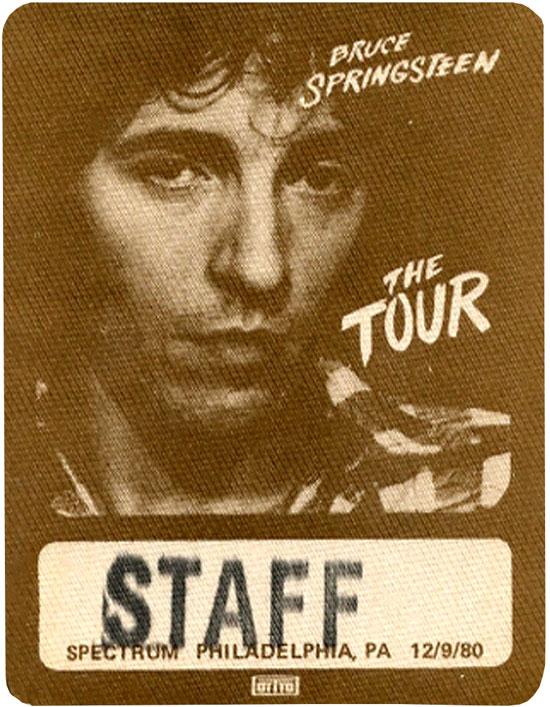 "I've seen people digging firebreaks to save their homes, I've seen some desperate fist fights, and I've seen hundreds of rock and roll shows," wrote Schruers, "but I have never seen a human being exert himself the way Springsteen did that night in Philly. His delivery of the last verse of 'Darkness on the Edge of Town" was raw with a mixture of anger, grief and determination. I'll remember 'Promised Land' for the way the silhouettes in the top tier were standing, striking the air with their fists. The crowd sang the refrain of 'Thunder Road' so hard you could feel your sternum hum." "I've seen people digging firebreaks to save their homes, I've seen some desperate fist fights, and I've seen hundreds of rock and roll shows," wrote Schruers, "but I have never seen a human being exert himself the way Springsteen did that night in Philly. His delivery of the last verse of 'Darkness on the Edge of Town" was raw with a mixture of anger, grief and determination. I'll remember 'Promised Land' for the way the silhouettes in the top tier were standing, striking the air with their fists. The crowd sang the refrain of 'Thunder Road' so hard you could feel your sternum hum."
"I've heard these songs a million fucking times, and it was like I never heard 'em before," said Miami Steve. "I've watched him write, months and months of digging, but last night was like you were in the same place he was when he wrote them."
The show ended, appropriately, with "Twist and Shout," Beatles style.

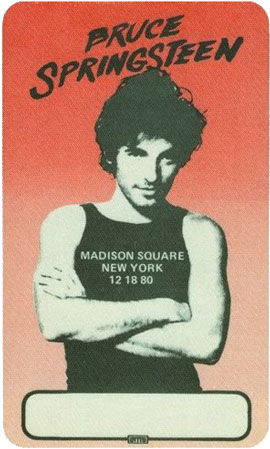 Following a swing through New England for single shows in Hartford and Providence and two at Boston Garden (where "I Wanna Marry You" with its "Here She Comes" extended intro made its last regular appearance), Bruce returned to Manhattan for the next pair of Madison Square Garden gigs, his last before the holidays. Following a swing through New England for single shows in Hartford and Providence and two at Boston Garden (where "I Wanna Marry You" with its "Here She Comes" extended intro made its last regular appearance), Bruce returned to Manhattan for the next pair of Madison Square Garden gigs, his last before the holidays.
With flashing Christmas lights slung over the amps, Bruce and the band debuted the Creedence classic "Who'll Stop the Rain," which became a permanent fixture. "Drive All Night," however, would only appear twice more on the tour.
"The reason Springsteen can whip up such an enthusiasm becomes apparent after the first number," enthused Record Mirror. "He attacked 'Born to Run' with an attitude that it was his last number on this planet and he wanted people to remember it. The energy he displayed on the opener left the mind exhausted, and that was only the beginning. He took material like 'Growin' Up,' 'Sandy,' 'Rosalita,' and 'Jungleland,' shook out all ideas of complacency, and injected it with power and vitality. A heavy chunk of The River was included, which accentuated the power of songs like 'Independence Day,' 'Point Blank,' and the title track. To say this is the best performance I've ever been to is an understatement."
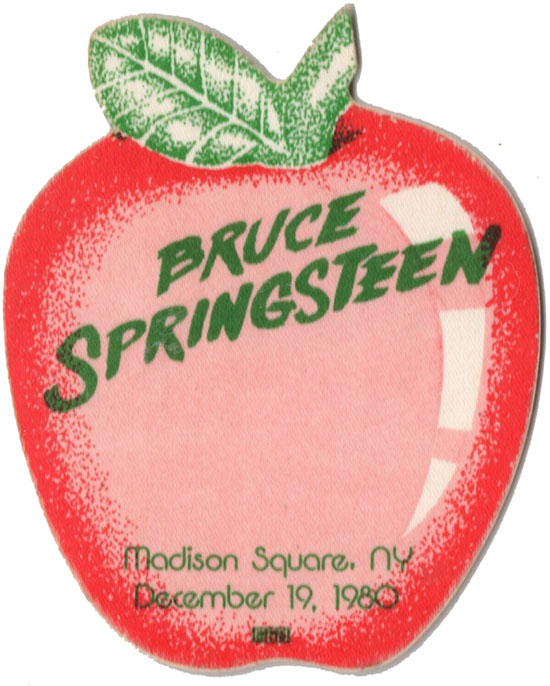
New Year's Eve on the island
After a nine-day Christmas break, Springsteen played three more New York City-area shows: December 28, 29, and 31 at Nassau Coliseum on Long Island (in Uniondale, NY). Prompted by the Garden scalping fiasco, promoter Ron Delsener contracted an independent accounting firm to process the ticket orders.
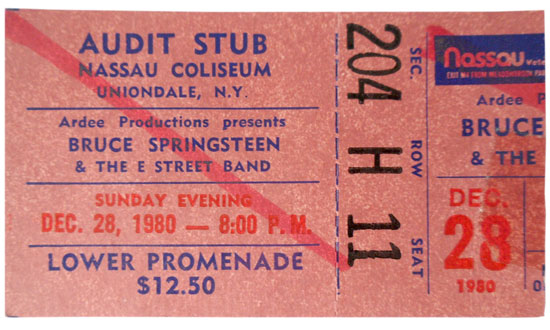
For these shows only, a cover of "Merry Christmas Baby" (recorded by Charles Brown, Elvis Presley, Otis Redding, and Chuck Berry, among others) increased the festive atmosphere. The first night's 33-song set brought the debut of Woody Guthrie's "This Land Is Your Land," which, like "Who'll Stop the Rain" before it, became one of the mainstays of the show until the end of the tour. The 35-song second concert opened with "Night" (the first of only five appearances) and included the only tour performance of "Incident on 57th Street," which segued seamlessly into "Rosalita," just as it does on record.
On New Year's Eve, the last of the three Nassau concerts, Bruce and the E Street Band pulled out all the stops and powered through a 38-song concert right into 1981. The performance lasted three hours and 47 minutes (again, minus intermission) and was unofficially recognized as their longest ever, for decades — until they finally broke the four-hour barrier in Helsinki in 2012. (An alternative theory among aficionados — based on information pertaining to tape speeds and calculation methods — suggests that the December 19, 1980 show in New York may have been marginally longer than the New Year's Eve gig in Uniondale).
This last show of 1980 included 12 songs from The River, six from Darkness on the Edge of Town, four from Born to Run, and three from Springsteen's first two albums (including a rare "Spirit in the Night"), plus unreleased original material ("Because the Night," "Fire," and the third and last "Rendezvous" of the tour) and a one-off (until 2008) performance of "Held Up Without a Gun."
The New Year's Eve show also featured nine covers: the Creedence, Guthrie, and Christmas songs; "In the Midnight Hour" and "Auld Lang Syne" special for the occasion; and the final three encores: "Detroit Medley," "Twist and Shout," and "Raise Your Hand."
 The Uniondale shows provided more source material for Live/1975-85. "Hungry Heart" and "Because the Night" were chosen from December 28; "You Can Look (But You Better Not Touch)," "Darkness on the Edge of Town" and "This Land Is Your Land" from December 29; and "4th of July Asbury Park (Sandy)" from December 31. The Uniondale shows provided more source material for Live/1975-85. "Hungry Heart" and "Because the Night" were chosen from December 28; "You Can Look (But You Better Not Touch)," "Darkness on the Edge of Town" and "This Land Is Your Land" from December 29; and "4th of July Asbury Park (Sandy)" from December 31.
Other songs from New Year's Eve were also released over the years. "Merry Christmas Baby" appeared on the B-side of the 1986 single "War" (7- and 12-inch formats) and on the 1987 charity album A Very Special Christmas. "Rendezvous" was included on the Tracks boxed set in 1998, and "Held Up Without a Gun" was on the limited-edition bonus disc with The Essential Bruce Springsteen in 2003. "Incident on 57th Street" from December 29 was also featured on the "War" 12-inch single and on the 1987 four-track Japanese Live Collection vinyl EP (later also released on CD).
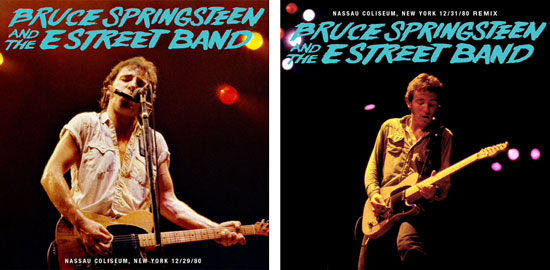
The December 31 Uniondale show was first released in Springsteen's Live Archive series in March 2015, and the December 29 concert followed in July 2019, together with a significant sonic upgrade of New Year's Eve.
After 47 surely exhausting shows, with the sound of the New Year's Eve crowd still ringing in their ears and another nine months of touring ahead, Springsteen and the E Street Band headed home for a three-week break before resuming the tour in Toronto in late January 1981.
COMING UP: Two months in "secondary markets"; Europe and the UK; The summer "victory lap"; A Night For The Vietnam Veterans, The Concluding Rites of Bossmania and more.
Mike Saunders reporting - Grateful acknowledgement to the various writers whose work I've quoted here, particularly Fred Schruers for his two excellent features in Rolling Stone and Dave Marsh for his extensive and revealing interview in Musician. Huge thanks also to Brucebase for being a Springsteen resource without equal.
|






